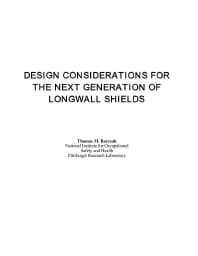Mining Publication: Design Considerations for the Next Generation of Longwall Shields
Original creation date: June 2001
Authors: TM Barczak
NIOSHTIC2 Number: 20021250
Proceedings of Longwall USA, Pittsburgh, Pennsylvania, June 13-15, 2001. Overland Park, KS: Intertec Publishing Corp., 2001; :17-38
Advancements in support technology have occurred to a large extent because of the demands of the mine operators. Shield supports are no exception. The most notable changes in shield technology in the past decade have been increases in shield capacity and life expectancy, which have increased by a factor of 4 and 7 respectively since the inception of the shield support 25 years ago. The purpose of this paper is to set goals for the future generations of longwall shields. These goals include: (1) 100,000 cycle life expectancy, (2) improved hydraulic diagnostic capability, (3) smart load control with adjustable setting pressure algorithms, (4) composite material design to reduce weight and increase shield width, (5) constant set leg cylinder design, (6) improved joint design to reduce wear and stress, (7) advancements in leg cylinder socket design, and (8) an instrumented shield to measure in-service structural component loading. These design issues will continue to push the envelope in longwall shield technology that has provided the safest and most productive mining system employed in the history of mining. In preparation for this, a historical examination of shield failures is made and recent trends in shield design are evaluated. Design practices to improve structural margins of current designs are also addressed.

NIOSHTIC2 Number: 20021250
Proceedings of Longwall USA, Pittsburgh, Pennsylvania, June 13-15, 2001. Overland Park, KS: Intertec Publishing Corp., 2001; :17-38
- Computer Design and Evaluation Tool for Illuminating Underground Coal-Mining Equipment
- Crewstation Analysis Programs - An Easy to Use Personal Computer-based Lighting and Visibility Analysis Software Package for Underground Mining Equipment
- Evaluation of Support and Ground Response as Longwall Face Advances into and Widens Pre-Driven Recovery Room
- Experiments on Personal Equipment for Low Seam Coal Miners: IV. Incorporating Coiled Cord Into Cap Lamp Battery Cords
- Inexpensive, Easy to Construct Materials-handling Devices for Underground Mines
- Laboratory Investigation of Seat Suspension Design Performance during Vibration Testing
- Laboratory Testing To Quantify Dust Entrainment During Shield Advance
- The NIOSH Shield Hydraulics Inspection and Evaluation of Leg Data (Shield) Computer Program
- Self-Reported Musculoskeletal Symptoms Among Operators of Heavy Construction Equipment
- Task Analysis